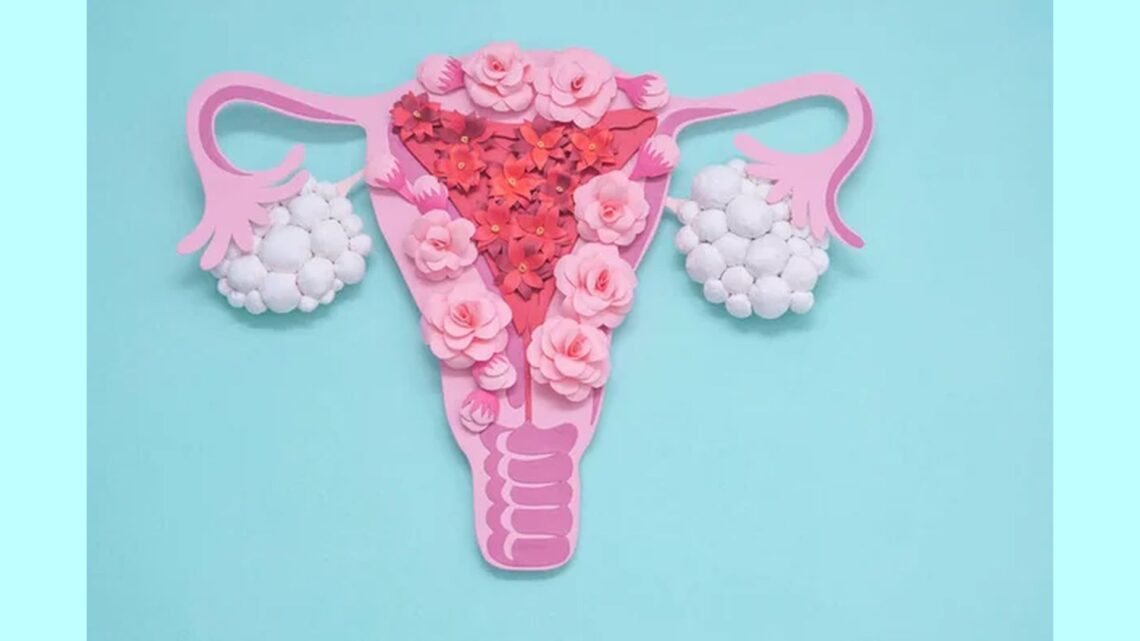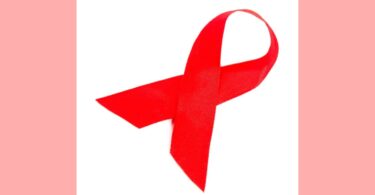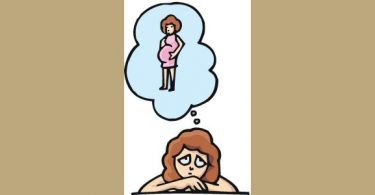ABSTRACT: Polycystic Ovarian Syndrome affects women of reproductive age. This heterogenous disorder is characterized by excessive androgen production by the ovaries. PCOS is a multifactorial and a polygenic condition. The following article deals with one such case of PCOS which has revealed promising results with Natrum Muriaticum as a constitutional remedy.
KEYWORDS: Homoeopathy, Polycystic Ovarian Syndrome, Natrum Muriaticum, Stein Leventhal Syndrome, Holistic approach.
CASE REPORT:
A 37-year-old married female, height 157 cm and weight 66 kgs with a clinical history of irregular menses for 1 year reported to the outpatient department (OPD) of GHMC, Bangalore on 8th July, 2022 with USG Abdomen and Pelvis report.
She presented with 4 months of amenorrhea and LMP was on April 6th, 2022 and her flow was protracted. She also complained of pain in the breast before menses. On examination the patient had body mass index of 26.8 kg/m2. She took allopathic medicines for 2 months to get her menstrual cycle regular but there was no improvement and she discontinued the drugs and started homoeopathic treatment.
PAST HISTORY:
- Vaccinated
- History of Chikungunya in 2005
FAMILY HISTORY:
| Paternal grandparents | Died | Due to old age |
| Maternal grandfather | Died | Due to Liver Cirrhosis |
| Maternal grandmother | Died | Due to Diabetes |
| Father | Died | During an accident, when I was 10 years |
| Mother | Alive | K/C/O Diabetes |
| Sibling (1 Elder Sister) | Alive | Apparently healthy |
| Husband | Alive | Apparently healthy |
| Children (adopted child-son) | Alive | Apparently healthy |
Table:1- Family History
PERSONAL HISTORY:
- Diet- mixed
- Appetite- 3 times a day
- Hunger- good. Can tolerate it
- Thirst- thirstless (1 litre/day)
- Desire- nothing Significant
- Aversion- fatty foods
- Micturition- D/N 3-4/0-1
- Bowel- normal, once a day satisfactory
- Sleep- good
- Dreams- remembers (daily activities)
- Perspiration- only on exertion
- Habits- nothing significant
- Thermals- Hot patient
SENSITIVITY:
- Sun- sensitive to sun, causes mild headache & heaviness
- Light- Artificial light causes irritation in the eyes
- Noise- Not sensitive
- Smell- Not sensitive
- Tight clothing- Doesn’t cause any irritation or disturbance.
LIFE SPACE INVESTIGATION:
The patient was born and brought up in Magadi, Bangalore. She studied up to 2nd PUC, couldn’t study further due to financial issues at home. She started working in garments factory and fell in love and got married at the age of 24 years. They lead a happy and content life for 3 years.
Her husband used to scold her with sarcastic comments in front of neighbors. She used to feel low and angered, When angered she wanted to be left alone. If someone consoles her, she gets irritated.
She came to know about her husband’s extra marital affair. Earlier, when she married him, she felt he will show her the fathers love and care. but he didn’t. She felt betrayed. and couldn’t express her feelings to anyone. She started blaming herself for choosing him in her life and at one instance she left the home and now, she is living separately.
She adopted her sister’s son and now they both are happy. During COVID pandemic, there was s financial crisis for them, now its better. By nature, she doesn’t mingle with people easily and has very few friends
MENTAL SYMPTOMS:
- Reserved
- Introvert
- Consolation aggravation
- Sensitive to criticism & rudeness
- Reproaches oneself
GENERAL PHYSICAL EXAMINATION:
- No signs of pallor, cyanosis, clubbing, icterus, lymphadenopathy, oedema.
- Nails-pink.
- Height- 157 cm
- Weight- 66 kg.
- Tongue- clean, moist.
- Skin- No abnormalities.
VITAL SIGNS:
- Temperature- afebrile at the time of examination
- Pulse- 70 bpm
- Respiratory rate- 16 breaths/m
- Blood pressure- 110/70 mm Hg
SYSTEMIC EXAMINATION:
- Respiratory system– AEBE, no added sounds
- Cardiovascular system- S1, S2 heard, no murmur
- GIT- Bowel sounds heard, per abdomen soft and tender
- Skin & Locomotor- nothing abnormalities detected
ANALYSIS OF THE SYMPTOMS:
| COMMON SYMPTOMS | UNCOMMON SYMPTOMS |
| Reserved | Menses protracted |
| Sensitive to criticism | Pain in the chest before menses |
| Reproaches oneself | Cyst in the left ovaries |
| Consolation aggravates | |
| Introvert | |
| Thirstless | |
| Fatty food aversion | |
| Sensitive to external impressions |
Table:2- Analysis of the symptoms
EVALUATION OF THE SYMPTOMS:
| MENTAL GENERALS | PHYSICAL GENERALS | CHARACTERISTIC PARTICULAR |
| Reserved ++ | Thirstless | Menses protracted |
| Sensitive to criticism + | Fatty food aversion | Pain in the chest before menses |
| Reproaches oneself + | Cyst in the left ovaries | |
| Consolation aggravation + | ||
| Introvert ++ |
Table:3- Evaluation of the symptoms
INVESTIGATION:
USG ABDOMEN & PELVIS – 30/06/2022
Polycystic Morphology of Left Ovary

Image-1 (Before treatment)
RUBRICS SELECTED:
- Mind– Reserved
- Mind– Sensitive criticism to
- Mind– Reproaches oneself
- Mind- Consolation- aggravation
- Stomach– Thirstless
- Generals– Food and Drink- Fat- Aversion
- Chest- Pain- Mammae- Menses- Before
- Menses- Protracted
- Female genital- Sex- Tumors- Ovaries
REPERTORIAL SHEET4: (Image-2)

Image-2
PRESCRIPTION: Natrum Muriaticum 200 1 dose Rubrum TID x 30 days
AUXILIARY MEASURES ADVISED:
- Include more fresh fruits and raw veggies and whole grains in diet and limit the processed food and trans-fat in the diet.
- Everyday advised for a brisk walk for 45-60 min.
FOLLOW UP:
| 9/8/22 | LMP – 15/7/2022
Flow– 10 days, colour- dark reddish brown, Clots- present, IMD-absent, pain in the chest before menses- tolerable, I could manage my daily activities with pain. Generals- better. |
Rx
Pl TID x 30 days |
| 10/9/22 | LMP – 16/8/2022
Flow- 5 days, colour- dark red, clots- present, IMD-present, Pain in the chest before menses- better, only heaviness is felt before menses. Generals- good. |
Rx
Pl TID x 30 days |
| 9/11/22 | LMP – 16/9/2022
Flow- 7 days, colour- dark red, clots-present, IMD-present, Pain in the chest before menses persisted, but tolerable. Generals- good. |
Rx
Natrum Muriaticum 200 1 dose PL TID x 30 days |
| 8/12/22 | LMP – 18/10/2022
Flow- 5 days, colour- bright red, clots- absent, IMD- present, pain in the chest before menses absent. Feeling enthusiastic at work. Generals-good. |
Rx
PL TID x 30 days To observe for the next 6 months and get back with USG abdomen and Pelvis scan |
| 10/6/2023 | LMP – 12/5/2023
Flow- 4 days, colour- bright red, clots- absent, IMD-present, pain- absent. Generals- good. No menstrual irregularity at all after homoeopathic treatment. Feels good about myself now. No regrets in life. |
USG Abdomen & Pelvis
No sonological abnormality in visualized organ. PCOS Cured. |
Table:3- Follow-up
DISCUSSION
There are several symptomatic treatments in conventional medicine. There is no specific remedy for PCOS in homoeopathy. Its treatment involves the selection of a constitutional homoeopathic remedy capable of working not only on the ovaries but also on the hypothalamic-pituitary-ovarian (HPO) axis of the patient. In this case, Natrum muriatium was found effective to treat the patient in a holistic approach.
Also, the possible causal attribution of the changes in this case were assessed by using the Modified Naranjo Criteria (Table 4). The total score for the case (+9), as per these criteria, is relatively close to the maximum of +13 and suggests positive causal attribution of the individualized homoeopathic treatment to the clinical outcome of the case found.
The physician needs to understand the patient in a holistic way for a clear prescription of an individualized homoeopathic remedy. Homoeopathy treats the individual in disease and not the disease alone. The Modified Naranjo Criteria for homoeopathy was originally adopted by Rutten from the Naranjo Algorithm.
It wss further developed over several years by the clinical data working group of the Homoeopathic Pharmacopoeia Convention of United States (HPCUS) to assess the likelihood of causal attributions of clinical outcome in homoeopathic cases and case report. According to the final outcome in a case a score is assigned in each domain of the Modified Naranjo Criteria of Homoeopathy.5
| Sl. no | MODIFIED NARANJO CRITERIA | YES | NO | NOT SURE | CASE |
| 1. | Was there an improvement in the main symptom or condition for which the homoeopathic medicine was prescribed? | +2 | -1 | 0
|
+2 |
| 2. | Did the clinical improvement occur within a plausible timeframe relative to the drug intake | +1 | -1 | 0 | +1 |
| 3. | Was there any initial aggravation of symptoms? | 0 | 0 | 0 | 0 |
| 4. | Did the effect encompass more than the main symptom or condition (i.e, were other symptoms ultimately improved or changed)? | +1 | 0 | 0 | +1 |
| 5. | Did overall well-being improve? (suggest using validated scale) | +1 | 0 | 0 | +1 |
| 6. | Direction of cure: did some symptoms improve in the opposite order of the development of symptoms of the disease? | 0 | 0 | 0 | 0 |
| Direction of cure: did at least two of the following aspects apply to the order of improvement of symptoms —from organs of more importance to those of less importance—from deeper to more superficial aspects of the individual—from the top downward. | +1 | 0 | 0 | +1 | |
| 7. | Did old symptoms (defined as nonseasonal and non-cyclical that were previously thought to have resolved) reappear temporarily during the course of improvements? | 0 | 0 | 0 | 0 |
| 8. | Are there alternate causes (other than the medicine) that—with a high probability—could have caused the improvement? (Consider the known course of the disease, other forms of treatment, and other clinically relevant interventions). | -3 | +1 | 0 | +1 |
| 9. | Was the health improvement confirmed by any objective evidence? (e.g., lab test, clinical observation, etc.) | +2 | 0 | 0 | +2 |
| 10. | Did repeat dosing, if conducted, create similar clinical improvement? | 0 | 0 | 0 | 0 |
| Total score (Maximum score= +13; Minimum score = -3) | 9 |
Table:4- Assessments by Modified Naranjo Criteria Scale

Image-3 (After homoeopathy treatment)
CONCLUSION:
This case study highlights the capability of individualized homoeopathic medicines. In this instance, a single dose of Natrum Muriaticum with infrequent repetition has been chosen.
DECLARATION OF PATIENT CONSENT: In the form, the patient has given her consent for her images and other clinical information to be reported in the journal. The patient understands that her name and initials will not be published and due efforts will be made to conceal her identity.
CONFLICT OF INTEREST: None declared.
FINANCIAL SUPPORT & SCHOLARSHIP: Nil.
REFERENCES:
- Ajmal N, Khan SZ, Shaikh R. Polycystic ovary syndrome (PCOS) and genetic predisposition: A review article. European journal of obstetrics & gynecology and reproductive biology: X. 2019 Jul 1;3:100060. S2590161319300948 Available from – https://www.sciencedirect.com/science/article/pii/
- Gupta G, Gupta N, Singh S, Varanasi R, Dewan D. Homoeopathic treatment of women with polycystic ovarian syndrome: A prospective observational study. Available from – http://aohindia.in/jspui/handle/123456789/7508
- Konar, H., DC Dutta’s Textbook of Gynaecology. 7th ed. New Delhi, India: Jaypee Brothers Medical Publishers, 2016.
- RADAR Software: Frederick Schroyens Synthesis Repertory, Version 9.1
- Teut et al. (2021) Case reporting in homeopathy—an overview of guidelines and scientific tools. Available at: https://www.researchgate.net/publication/354589265_Case_Reporting_in_Homeopathy-An_Overview_of_Guidelines_and_Scientific_Tools
- Kent JT. Repertory of the Homoeopathic Materia Medica. Enriched Indian ed. New Delhi. B Jain Publishers(P) Ltd;2017.
- Hahnemann, S., Boericke, W. and Dudgeon, R., 2011. Organon of medicine. New Delhi: B. Jain Publishers






